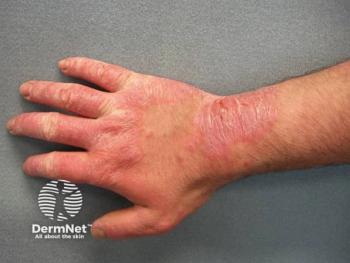
Human Skin Models Advance EBS Research
Key Takeaways
- Cory Simpson's research focuses on developing patient-specific treatments for Epidermolysis Bullosa Simplex using a human tissue-based model.
- Techniques like CRISPR and patient-derived stem cells are employed to create personalized models for testing treatments.
Traditional mouse models for EBS are limited, prompting Simpson's lab to create more accurate human-based tissue models.
In a recent interview with Dermatology Times, Cory Simpson, MD, PhD, assistant professor and physician-scientist at the University of Washington, discussed his research into novel, patient-specific approaches to treating Epidermolysis Bullosa Simplex (EBS), a rare genetic blistering disorder with no approved therapies. Simpson presented on this program at the
Traditionally, modeling diseases like EBS in the lab has been limited. “There was a mouse model, but unfortunately, the mice passed away very early in life, so it’s hard to use that type of model to study a disease,” Simpson explained. To address this, his team developed a human tissue–based model capable of replicating the disease’s key pathologies.
Now, Simpson’s research is focused on enhancing this model to reflect the complex genetic diversity of EBS. “We’re using this model... to create more of a personalized model that would represent each patient’s individual disease,” he said. This involves techniques such as CRISPR-based DNA editing and cultivating patient-derived stem cells into lab-grown skin. These innovations offer the potential to test treatments on patient-specific skin tissue before any clinical intervention, increasing the likelihood of both efficacy and safety.
Simpson’s team also applies RNA sequencing to explore cellular pathways that may be disrupted in EBS, which could reveal novel drug targets. One promising avenue involves the use of MEK inhibitors. “MEK inhibitors can actually change the complement of keratins, which are the sort of structural bones of the cell,” he noted, suggesting that modifying keratin expression might compensate for defective keratins in EBS patients.
However, Simpson emphasizes caution in translating lab findings into clinical therapies. “There are many, many mice that have been cured of cancer... but most of those therapies, when you actually test them in a clinical trial, don’t always work,” he said. Despite this, the goal remains to identify “lead drugs” that are already proven safe in other contexts and could be repurposed for EBS under off-label use—a common practice in dermatology given the lack of approved treatments for many rare skin diseases.
Ultimately, Simpson's vision is rooted in equity: “We really believe... that every patient deserves a chance for a cure, no matter how rare the disease is.” His work represents a significant step toward making personalized dermatologic medicine a practical reality for patients with rare genetic conditions.
Newsletter
Like what you’re reading? Subscribe to Dermatology Times for weekly updates on therapies, innovations, and real-world practice tips.



















